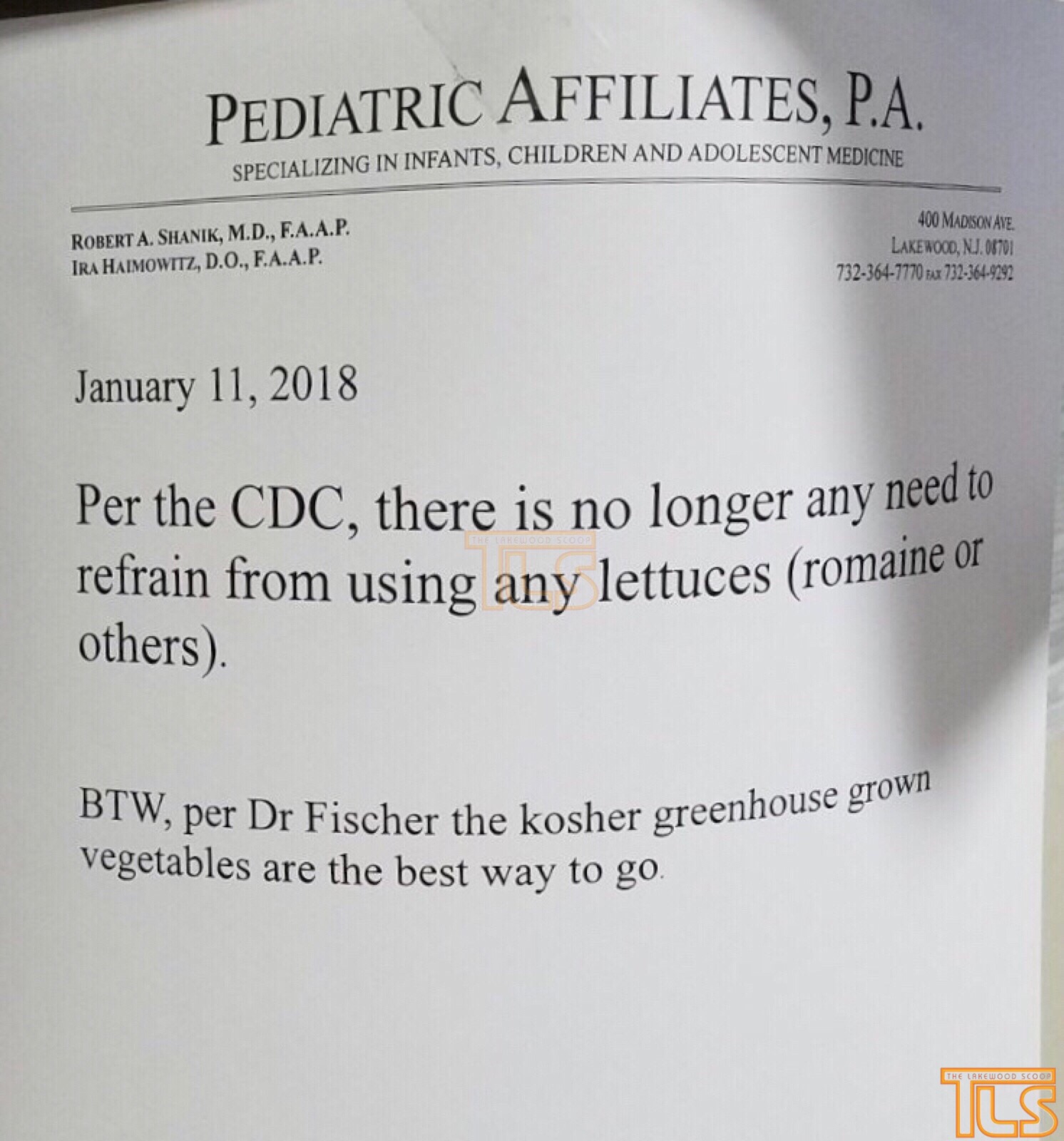As YWN has been reporting, an E. Coli outbreak across the United States and Canada has sickened dozens and killed 1 person in each country. American officials said that the outbreak was most likely caused by ”leafy greens,” while their counterparts in Canada specifically identified romaine lettuce as the source of the infections there.
On Tuesday, prominent Lakewood pediatrician Dr. Reuven Shanik warned the public against eating all kinds of lettuce and cabbage until “until they can figure it out.” The food-safety experts at leading consumer advocacy group Consumer Reports advised avoiding romaine lettuce, any products with romaine in them, a warning reiterated on Wednesday evening.
On Thursday, Dr. Shanik announced cabbage and lettuce are once again safe to eat. TLS reports this development came after a phone conversation between Dr. Shanik and another prominent doctor who specializes in infectious diseases, as well as an update from the CDC.

On Wednesday, the Public Health Agency of Canada announced it was no longer advising the public against eating romaine lettuce. The U.S. Centers for Disease Control and Prevention (CDC) said in a statement there was “likely” no longer a concern.
The last reported illness in the United States was on Dec. 12, suggesting that the risk of buying food contaminated in the current outbreak had passed.
“The likely source of the outbreak in the United States appears to be leafy greens, but officials have not specifically identified a type of leafy greens eaten by people who became ill,” the CDC said Wednesday.
However, officials added: “Leafy greens typically have a short shelf life, and since the last illness started a month ago, it is likely that contaminated leafy greens linked to this outbreak are no longer available for sale.”
Consumer Reports has not yet announced an end to it’s warning. “We think it’s important to avoid eating romaine until the cause of this outbreak is determined,” read a statement on Wednesday.
Of note, the CDC also announced Wednesday that their count of people infected had climbed to 24, and cases had been found in 2 additional states. Maryland and New Jersey now join California, Connecticut, Illinois, Indiana, Michigan, Nebraska, New Hampshire, New York, Ohio, Pennsylvania, Vermont, Virginia and Washington, which all previously reported cases of illness. Nine of those people have been hospitalized, two of whom are suffering from a form of kidney failure. There has been one death in California, which was previously reported as connected to the outbreak.
In Canada, 42 people were sickened and one person died. Neither country had identified the source of the contaminations, and to where or how the affected produce was distributed.
The CDC continues to interview sick people in the United States to determine what they ate in the week before their illness started. Of 13 people interviewed, all 13 reported eating leafy greens. Five (56%) of nine ill people specifically reported eating romaine lettuce. This percentage was not significantly higher than results from a survey of healthy people in which 46% reported eating romaine lettuce in the week before they were interviewed. Based on this information, U.S. health officials concluded that ill people in this outbreak were not more likely than healthy people to have eaten romaine lettuce. Ill people also reported eating different types and brands of romaine lettuce. Currently, no common supplier, distributor, or retailer of leafy greens has been identified as a possible source of the outbreak. CDC continues to work with regulatory partners in several states, at the U.S. Food and Drug Administration, and the Canadian Food Inspection Agency to identify the source.
Although the most recent illness started on December 12, there is a delay between when someone gets sick and when the illness is reported to CDC. For STEC O157:H7 infections, this period can be two to three weeks. Holidays can increase this delay. Because of these reporting delays, more time is needed before CDC can say the outbreak in the United Stated is over. This investigation is ongoing.
Advice to Consumers
CDC is not recommending that U.S. residents avoid any particular food given the short shelf life of leafy greens and because a specific type of leafy greens has not been identified.
Symptoms of E. coli Infections
Most people develop diarrhea (often bloody) and stomach cramps. People usually get sick from E. coli O157:H7 three to four days after eating food contaminated with the germ. If you are concerned that you have an E. coli infection, talk to your healthcare provider.
General Recommendations for Preventing E. coli Infections
You can protect yourself by washing your hands thoroughly before and after preparing or eating food. You can also wash counters, cutting boards, and utensils after they touch raw meat to avoid contaminating other foods. It’s also important to avoid preparing food when you are sick, particularly if you are sick with diarrhea.
(YWN World Headquarters – NYC)












3 Responses
This is a professional organization? They basically caused bunch of businesses to lose money because of a guess that didnt work out. And instead of actually testing lettuce from different companies they now decided that it must be safe to eat since no one else got sick? Next time i’ll ask my 2 year old for a smarter and more reliable info about health concerns.
The CDC didn’t cause anyone to lose business. The CDC and FDA NEVER advised against eating Romaine. Best to always read the CDC and FDA advisories and not to get caught up with the popular hype.
“Per the CDC there is no longer any need to refrain from using any lettuces (romaine or others)”
Per the CDC there was NEVER any need to refrain from using any lettuces. The CDC never called for people to do so. There was no recall, nothing. The stupid panic is entirely the fault of a publication that makes its money by scaring people, and credulous people and websites who repeated its propaganda.